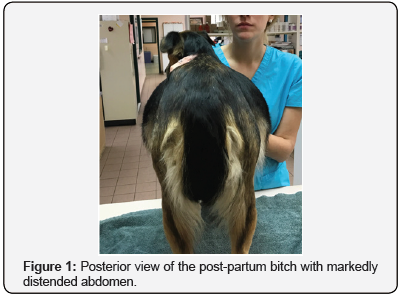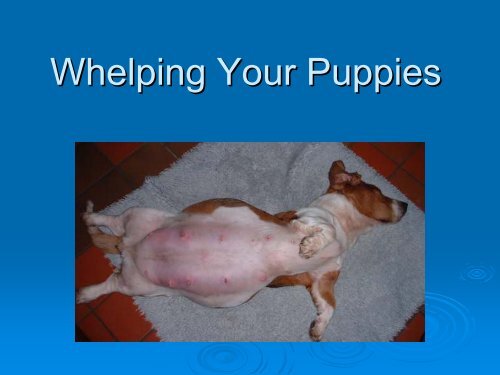
An idle uterus is the ideal setting for pyometra Dr. Affected bitches usually appear normal with no signs of illness or weakness unless the bleeding is so marked that anaemia results.

Pyometra occurs commonly in older intact female dogs and will begin several weeks after a heat cycle.
Pyometra after whelping. All 28 bitches had visible vaginal discharge before treatment with aglepristone started that is open cervix pyometra. One bitch showed clinical signs of pyometra 7 weeks after whelping. Of the bitches six had been mated before they developed clinical signs of the disease.
Additional case history and clinical findings are presented in Table 1. Bitches whelping rarely or never in their lives have a greater chance of developing pyometra with rare or no occurrence of pregnancy. For unknown reasons gestation has a protective action on the canine endometrium causing pyometra not to develop in areas of the endometrium where placental attachment has occurred although pyometra can occur in one horn with pregnancy.
Unlike pyometra metritis is most often a bacterial uterine infection that develops in the immediate post partum after giving birth period and occasionally after abortion or breeding. It is most often associated with retained fetuses or placentas. One bitch showed clinical signs of pyometra 7 weeks after whelping.
Of the bitches six had been mated before they developed clinical signs of the disease. Addi-tional case history and clinical findings are presented in Table 1. Bacterial culture results and antimicrobial drugs The bacteria isolated in 11 sampled bitches were E.
Pyometra most often occurs 4-12wks after their season ends so it is important to know the signs and symptoms. Because of false pregnancies and the risk of pyometra most Reproductive Veterinarians including Dr. Hutchinson suggest that you do your clearances and then do your breeding while your dog is young.
A canine pyometric uterus immediately after surgery to remove it. Though it is most commonly known as a disease of the unaltered female dog it is also a notable human disease. It is also seen in female cattle horses goats sheep swine cats queens rabbits hamsters ferrets rats and guinea pigs.
How long will a female dog bleed after whelping. In some cases bleeding may last for weeks or months after the whelping before it resolves naturally. Oxytocin and antibiotics are of no assistance in these cases.
Affected bitches usually appear normal with no signs of illness or weakness unless the bleeding is so marked that anaemia results. A reddish-brown mucous vaginal discharge after whelping is normal for about three weeks. If the discharge looks like pus becomes bright red is of a large amount or lasts longer than three weeks call the doctor.
This dependable high potency remedy can be used when there is difficulty during labor or uterine inertia. It helps to revive labor contractions and can be used in place of Pituitrin injections. Also can be given after whelping to release retained afterbirths.
It is also useful in promoting drainage in open pyometra. An idle uterus is the ideal setting for pyometra Dr. Taking steps to optimize the potential for successful breeding after medical management is helpful.
This involves using precise ovulation timing selecting a proven stud dog that has sired a litter within the previous six months breeding twice during the fertile. It usually occurs within 12 weeks after a heat cycle. Pyometra can occur in either a closed or open cervix.
In a closed pyometra the bitch. Pyometra is an infection of the uterus the reproductive organ of a female dog. The uterus becomes filled with pus and the infection can spread systemically leading to sepsis.
Pyometra occurs commonly in older intact female dogs and will begin several weeks after a heat cycle. Pyometra is caused by a bacterial infection most commonly E. Coli and often occurs a few weeks after a female has finished a season.
This is because being in season causes the animals body to go through hormonal changes. Yet 20 percent of intact bitches are at risk of developing the potentially fatal disease pyometra by 10 years of age a disease that may end their chance of whelping puppies should it. Pyometra is most common within the first two months after a heat cycle as that is when the hormonal progesterone levels increase to support a pregnancy even if no pregnancy occurs.
About two months after estrus the girl will have a false whelping erroneously called a false pregnancy and her breasts may enlarge and she may mother toys. Pyometra is an infection that can result from hormonal changes that work during heat to prevent white blood cells from entering the bitchs uterus. If the white blood cells were not suppressed during the heat the bitchs immune system would either damage or kill the males sperm and breeding would not be successful.
-Pyometra doesnt occur after whelping. Bleeding post-whelping is normal up to how long in the bitch- When do you worry of subinvolution of placental sites- Pyometra-LH level lutenizing hormone is low an ovarian remnant is likely. Initially pyometra was suspected but pyometra is a progesterone- mediated uterine disease occurs during diestrus 1 not during post-whelping period due to absence of ovarian corpus luteum and progesterone production.
In most of the bitches with pyometra polyuriaor polydipsia are reported which were not reported in our case. Eclampsia mastitis and even pyometra are all diseases that can commonly occur after whelping. We have treatment options for all of these and more to.
With accumulation of pus in the uterus known as pyometra. Signs of pyometra include vomiting and lack of appetite known as anorexia Bloody discharge more than 8 weeks after whelping often due to subinvolution of placenta sites. Pyometra is the life-threatening infection of the uterus that generally occurs in middle-aged to older female dogs in the 6 weeks following heat.
A uterus with pyometra swells dramatically and is filled with pus bacteria dying tissue and toxins. Without treatment the pet is expected to die. Pyometra is extremely serious and can be life-threatening if left untreated.
The sooner your dog receives treatment the better their chance of survival. The good news is many dogs will make a full recovery after treatment if the condition is caught early so dont delay in taking them to the vet if you are concerned.